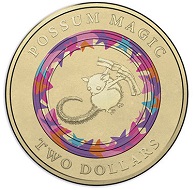April 26, 2018 – While the directors of mints from all over the world are meeting in Seoul at the 30th Mint Directors Conference, the media in Australia and Canada are full of articles about the recent development of the legal dispute between the two mints. They are litigating because of a method for printing color onto coins fast enough to be used for manufacturing circulation coins.
The lawsuit now also covers the very popular Australian coins celebrating the widely read “Possum Magic” children’s book.
Back in March, the Royal Canadian Mint had sued for five additional coin runs with color application. The lawsuit now concerns over 15 million items, including the commemorative coins with a poppy design issued between 2015 and 2017 for Remembrance Day, Olympic-themed coins of which about 12 million went into circulation, an Anzac Day coin commemorating Australian and New Zealand war dead and veterans, and the popular “possum coins”, a series of items referring to a famous Australian children’s book.
The Royal Canadian Mint is demanding that all coins remaining in the mint be destroyed and that the profit made with those already sold as well as damages be paid to the Royal Canadian Mint. Naturally, it also wants the court to bar the Australian mint from further using the color-printing method.
The Royal Australian Mint does not take the lawsuit sitting down. The Australian government, in charge of its state mint, has launched a counter claim in which it contests the fact that the patent of 2006, which was granted in 2013, even has legal footing. According to the Australians, there were not enough novelties about this method to grant a patent for it. The counter claim includes a list of Canadian, American and British patents which had been publicly available before the new patent. The Australian government also describes the details of the Australian method, seeking to prove that it does not copy the Canadian one.
The last argument of the Australians can most likely only be understood by lawyers. They claim that, in this precise case, the patent was not even applicable, since the method in question is part of “ordinary business […] for the services of the Commonwealth”, and thus, under Australian law, does not infringe the patent.
The next hearing is scheduled for June 2018, but one thing is already clear: The winners are the lawyers, the losers both mints – in terms of money and reputation.
Naturally, CoinsWeekly reported on the original lawsuit.
The legally most detailed article on the newest lawsuit can be found in the Canadian National Post.
The BBC reported on the case as well, but not very extensively.
Huffington Post offered what is pobably the most concise roundup.






